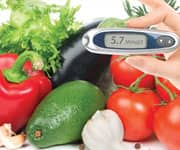Life Extension Magazine®

Scott Fogle, ND
Q: I noticed that on a recent blood test my fasting blood sugar is 105 mg/dL. Last checkup it was 100 mg/dL. My doctor says it’s fine and not to worry but everything I’ve read tells me that I might be on the road to diabetes or have something called impaired insulin sensitivity (or insulin resistance). Can you suggest some blood tests that would give me a better picture of my risk factors, especially since both diabetes and high cholesterol issues run in my family?
A: That is a great question, and you are wise to raise it. You may have the condition referred to as “impaired glucose tolerance,” also known as “insulin resistance” or “prediabetes.” In other words, your glucose level is indeed too high if your goal is optimal health.
Here’s why…
Though mainstream medicine once tolerated blood sugars as high as 140 mg/dL as “normal,” we now recognize the substantial cardiovascular, stroke, and cancer risks posed by sugar levels anywhere above 85 mg/dL.1-4 Above that level, your tissues are exposed to glucose at concentrations that cause chemical reactions with your body’s proteins and fats called glycation. Glycated proteins and fats trigger inflammation and oxidative stress, major enemies of longevity. Virtually all chronic diseases of aging (and aging itself) are accelerated by high glucose levels. As blood sugar rises, your risk of dying also goes up by approximately 40% when fasting glucose consistently falls in the range of 110-124 mg/dL. Risk of dying doubles when fasting glucose reaches the range of 126-138 mg/dL.5
But glucose is only part of the story. In order to keep your sugar under control, your body puts out increasingly large amounts of insulin, the hormone we need to take sugar out of the bloodstream and drive it into cells. And insulin, while critically important for acute blood sugar control, poses a problem in the longer term.
Insulin is a growth factor, so too much insulin can predispose you to many kinds of cancer, as well as to heart disease, stroke, and the process of accelerated aging.6-18
In other words, your body may be putting out high amounts of insulin just to keep your blood sugar as “low” as 100 to 105 mg/dL, but you are not out of the woods! To get a better idea of your overall risk, you’ll need to know more than just a fasting blood sugar level. You’ll need to know your insulin levels as well, particularly how much insulin it takes to get your blood sugar levels under control after you eat but most doctors never think to order those tests. Ideally, it shouldn’t take too much insulin; if it does, then that is an early warning sign of insulin resistance.
There’s more. Fasting blood glucose gives you no information about how your body handles the inevitable glucose load after a meal. Studies show that the 2-hour after-meal (postprandial) glucose level correlates most strongly with catastrophic outcomes like cardiovascular disease, so getting fasting sugar under control is only half of the battle.19 This all goes to say that you’ll want to get some measurement of your glucose and insulin levels following a standard glucose load, in order to get an idea about how your own individual body manages it.
Three Tests to Assess Blood Sugar Management
Let’s take a look at a group of three tests that together give you the best picture of your blood sugar when fasting and after a meal, your insulin levels when fasting and after a meal, the amount of glucose-related damage your body’s proteins are undergoing, and the way your lipid profile is being affected by your blood sugar. Using the results from these tests can help you and your physician avoid the devastating damage caused by high blood sugar.
Glucose Tolerance Test with Insulin

A glucose tolerance test with insulin provides your body with a single, precisely measured dose of glucose, and then measures your blood sugar and insulin responses over a total of three hours. You’ll fast overnight (just like for any routine fasting blood sugar test), and on the morning of the test you’ll have a fasting blood glucose and insulin level drawn to establish your baseline. This also gives you an up-to-date measurement of your fasting glucose.
You’ll then be given a drink containing 75 grams of glucose, and asked to wait. At one, two, and three hours after you drink this glucose “challenge” dose, technicians will draw additional blood glucose and insulin levels. (Don’t forget to bring a book, tablet, or laptop to keep yourself quietly occupied; the test requires that you remain seated at the test site until it is finished.)
The results of this test will show you what your body does with a known glucose load. If you are healthy, you’ll have a baseline fasting glucose of 70-85 mg/dL, and a low fasting insulin level (less than 5 µIU/mL). Over the next few hours, you’ll see a rise in blood glucose as your body absorbs it from your intestine, but that rise should be tempered by a slight increase in insulin.
By two hours, your glucose should not rise above 140 mg/dL or ideally not above 125 mg/dL (or more than 40 mg/dL above your baseline value); higher two-hour postprandial glucose levels are strongly associated with a host of dangerous outcomes (Table 1).20 But — and here’s the most important point — you’ll also have a simultaneous measurement of your insulin level. While it’s good to have normal fasting and after-meal blood sugar levels, you still have a problem if your corresponding insulin levels are too high.
If you’ll invest just three or four hours of your time, the glucose tolerance test with insulin will give you a more accurate picture of where you are right now, in terms of fasting and after-meal glucose and insulin. And that information will give you powerful clues to your risk factors, not only for diabetes, but also for all kinds of age-related conditions. If your results are abnormal, you’ll have a clear roadmap of how to respond, and an excellent measuring tool to track your progress.
TABLE 1: The Dangers of After-Meal Blood Sugar Elevations20
 |
- Retinal damage to the eye
- Arterial blockage
- Oxidative stress
- Increased inflammation
- Endothelial dysfunction
- Reduced coronary blood flow
- Increased cancer risk
Hemoglobin A1c
The glucose tolerance test with insulin gives you great information about where your body is right now, on the day of the test. To complement that information, you’ll want some measure of longer-term sugar-induced glycation damage to your body’s protein and lipid molecules. The standard test for that is hemoglobin A1c (HbA1c), a direct measurement of glycation damage to hemoglobin, one of the most important molecules in your body, and one that is readily measured with a simple blood test.
If a fasting or after-meal glucose is a snapshot, think of hemoglobin A1c as a security camera recording that tracks where you’ve been over the past 2-3 months.19 Hemoglobin A1c results are reported as the percent of total hemoglobin that’s been damaged by glycation; a level of less than 5.7% is considered good, but 5% is even better. If your level is higher than 5.7%, it means your body has been seeing too much sugar for too long — and that means your insulin levels will also likely have been elevated as your body tries to cope, with potentially disastrous consequences. Studies show that the risk of heart attack, stroke, and cancer all go up with rising levels of hemoglobin A1c.21-23 And one of the strongest correlations with frailty in older adults is a persistently elevated hemoglobin A1c level.24,25
VAP™ Test for Lipids
Although it doesn’t measure glucose or insulin, the vertical auto profile (VAP™) test is especially valuable for people with borderline or elevated blood sugar. That’s because both impaired glucose tolerance and full-blown diabetes are associated with blood lipid disturbances that create a very high cardiovascular disease and stroke risk; one of the major risks is from smaller-than-normal particles of low density (LDL) cholesterol.26-29
Unlike standard lipid profiles, a single VAP™ test directly measures all of the major cholesterol-related particles that have known impact on heart and blood vessel health.30,31 This includes the so-called “small remnant” particles, basically leftovers from LDL- and very-low density lipoproteins (VLDL) that are independently associated with increased risk.
Why Know This Information?

Simply because, as with the situation of a “normal” glucose but elevated insulin, you might have met your goal of a low LDL and a higher HDL, but still be at risk. This was shown in a study that looked at people who had reached “normal” levels of non-HDL cholesterol. Depending on their baseline risk, 63 to 88% of those people still turned out to have small low-density particle size, meaning that they were still at significantly raised risk for cardiovascular disease.32 A decrease in LDL size is associated with a 28% increase in heart attack risk in men and a 130% increase in risk among young women.33,34 This is because small, dense LDL can penetrate the cells lining your arteries much easier than large bouyant LDL, thus leading to arterial plaque faster.
VAP™ testing also measures the important lipoproteins Lp(a) and B100, and the subcategories of HDL cholesterol, HDL-2 and HDL-3. HDL-2 may offer the greatest cardiovascular protection; people with HDL-2 cholesterol less than 25 mg/dL have a fourfold increased risk of a heart attack compared with those who have higher levels.35
Lp(a) and B100 particles are also associated with increased cardiovascular risk, and both are found in abnormally large quantities in people with diabetes or insulin resistance.36 People with elevated Lp(a) have a 79% increase in stroke risk, while those with a history of smoking and elevated Lp(a) are four times likelier to have blood vessel diseases.37,38 APO B100 is correlated to your LDL particle number, and the higher the number the greater the chance your LDL is being oxidized and glycated, both of which contribute to more plaque in arteries.39
Summary
It is a good idea not to ignore a “borderline” fasting blood sugar result, especially in light of the current recommendations to keep blood sugar at 85 mg/dL or lower. Even a marginally-elevated glucose level may mask a dangerously high insulin level; fasting glucose measurements also provide no information about the after-meal glucose surge that does much of the damage.
People concerned about their glucose should consider three tests: a glucose tolerance test with insulin measurement, a hemoglobin A1c, and a VAP™ lipid profile. The results of those tests will give you a customized assessment of your cardiovascular risk status.
If you have any questions on the scientific content of this article, please call a Life Extension® Health Advisor at 1-866-864-3027.
Dr. Scott Fogle is the Director of Clinical Information and Laboratory Services at Life Extension® where he oversees scientific and medical information and is in charge of its health advisors as well as its laboratory division.
References
- The Expert Committee on the Diagnosis and Classification of Diabetes Mellitus. Report of the Expert Committee on the Diagnosis and Classification of Diabetes Mellitus. Diabetes Care. 2002 Jan;25(1):s5-s20.
- Bjornholt JV, Erikssen G, Aaser E, et al. Fasting blood glucose: an underestimated risk factor for cardiovascular death. Results from a 22-year follow-up of healthy nondiabetic men. Diabetes Care.1999 Jan;22(1):45-9.
- Levitan EB, Song Y, Ford ES, Liu S. Is nondiabetic hyperglycemia a risk factor for cardiovascular disease? A meta-analysis of prospective studies. Arch Intern Med. 2004 Oct 25;164(19):2147-55.
- Jee SH, Ohrr H, Sull JW, Yun JE, Ji M, Samet JM. Fasting serum glucose level and cancer risk in Korean men and women. JAMA.2005 Jan 12;293(2):194-202.
- Sorkin JD, Muller DC, Fleg JL, Andres R. The relation of fasting and 2-h postchallenge plasma glucose concentrations to mortality: data from the Baltimore Longitudinal Study of Aging with a critical review of the literature. Diabetes Care.2005 Nov;28(11):2626-32.
- Bennet AM, Brismar K, Hallqvist J, Reuterwall C, De Faire U. The risk of myocardial infarction is enhanced by a synergistic interaction between serum insulin and smoking. Eur J Endocrinol. 2002 Nov;147(5):641-7.
- Chao LT, Wu CF, Sung FY, et al. Insulin, glucose and hepatocellular carcinoma risk in male hepatitis B carriers: results from 17-year follow-up of a population-based cohort. Carcinogenesis.2011 Jun;32(6):876-81.
- Dankner R, Shanik MH, Keinan-Boker L, Cohen C, Chetrit A. Effect of elevated basal insulin on cancer incidence and mortality in cancer incident patients: the Israel GOH 29-year follow-up study. Diabetes Care.2012 Jul;35(7):1538-43.
- Del Giudice ME, Fantus IG, Ezzat S, McKeown-Eyssen G, Page D, Goodwin PJ. Insulin and related factors in premenopausal breast cancer risk. Breast Cancer Res Treat. 1998 Jan;47(2):111-20.
- Farquharson AJ, Steele RJ, Carey FA, Drew JE. Novel multiplex method to assess insulin, leptin and adiponectin regulation of inflammatory cytokines associated with colon cancer. Mol Biol Rep. 2012 May;39(5):5727-36.
- Keku TO, Lund PK, Galanko J, Simmons JG, Woosley JT, Sandler RS. Insulin resistance, apoptosis, and colorectal adenoma risk. Cancer Epidemiol Biomarkers Prev. 2005 Sep;14(9):2076-81.
- 12. Kuhl H. Breast cancer risk in the WHI study: the problem of obesity. Maturitas.2005 May 16;51(1):83-97.
- Krentz A, Viljoen A, Sinclair A. Insulin resistance: a risk marker for disease and disability in the older person. Diabet Med. 2012 Nov 22. doi: 10.1111/dme.12063. [Epub ahead of print]
- Ma J, Giovannucci E, Pollak M, et al. A prospective study of plasma C-peptide and colorectal cancer risk in men. J Natl Cancer Inst. 2004 Apr 7;96(7):546-53.
- Michaud DS, Fuchs CS, Liu S, Willett WC, Colditz GA, Giovannucci E. Dietary glycemic load, carbohydrate, sugar, and colorectal cancer risk in men and women. Cancer Epidemiol Biomarkers Prev. 2005 Jan;14(1):138-47.
- Pradhan AD, Manson JE, Meigs JB, et al. Insulin, proinsulin, proinsulin:insulin ratio, and the risk of developing type 2 diabetes mellitus in women. Am J Med. 2003 Apr 15;114(6):438-44.
- Troisi R, Potischman N, Hoover RN, Siiteri P, Brinton LA. Insulin and endometrial cancer. Am J Epidemiol.1997 Sep 15;146(6):476-82.
- Yun SJ, Min BD, Kang HW, et al. Elevated insulin and insulin resistance are associated with the advanced pathological stage of prostate cancer in Korean population. J Korean Med Sci. 2012 Sep;27(9):1079-84.
- Woerle HJ, Neumann C, Zschau S, et al. Impact of fasting and postprandial glycemia on overall glycemic control in type 2 diabetes Importance of postprandial glycemia to achieve target HbA1c levels. Diabetes Res Clin Pract.2007 Aug;77(2):280-5.
- Available at: http://www.idf.org/sites/default/files/postmeal%20glucose%20guidelines.pdf. Accesed January 29, 2013.
- Hsu YC, Chiu HM, Liou JM, et al. Glycated hemoglobin A1c is superior to fasting plasma glucose as an independent risk factor for colorectal neoplasia. Cancer Causes Control. 2012 Feb;23(2):321-8
- Oh HG, Rhee EJ, Kim TW, et al. Higher glycated hemoglobin level is associated with increased risk for ischemic stroke in non-diabetic korean male adults. Diabetes Metab J. 2011 Oct;35(5):551-7.
- Timmer JR, Hoekstra M, Nijsten MW, et al. Prognostic value of admission glycosylated hemoglobin and glucose in nondiabetic patients with ST-segment-elevation myocardial infarction treated with percutaneous coronary intervention. Circulation.2011 Aug 9;124(6):704-11.
- Kalyani RR, Tian J, Xue QL, et al. Hyperglycemia and incidence of frailty and lower extremity mobility limitations in older women. J Am Geriatr Soc. 2012 Sep;60(9):1701-7.
- Blaum CS, Xue QL, Tian J, Semba RD, Fried LP, Walston J. Is hyperglycemia associated with frailty status in older women? J Am Geriatr Soc. 2009 May;57(5):840-7.
- Stoney RM, O’Dea K, Herbert KE, et al. Insulin resistance as a major determinant of increased coronary heart disease risk in postmenopausal women with Type 2 diabetes mellitus. Diabet Med. 2001 Jun;18(6):476-82.
- Garvey WT, Kwon S, Zheng D, et al. Effects of insulin resistance and type 2 diabetes on lipoprotein subclass particle size and concentration determined by nuclear magnetic resonance. Diabetes.2003 Feb;52(2):453-62.
- Festa A, Williams K, Hanley AJ, et al. Nuclear magnetic resonance lipoprotein abnormalities in prediabetic subjects in the Insulin Resistance Atherosclerosis Study. Circulation.2005 Jun 28;111(25):3465-72.
- Goff DC, Jr., D’Agostino RB, Jr., Haffner SM, Otvos JD. Insulin resistance and adiposity influence lipoprotein size and subclass concentrations. Results from the Insulin Resistance Atherosclerosis Study. Metabolism.2005 Feb;54(2):264-70.
- Kulkarni KR. Cholesterol profile measurement by vertical auto profile method. Clin Lab Med. 2006 Dec;26(4):787-802.
- Kulkarni KR, Marcovina SM, Krauss RM, Garber DW, Glasscock AM, Segrest JP. Quantification of HDL2 and HDL3 cholesterol by the Vertical Auto Profile-II (VAP-II) methodology. J Lipid Res. 1997 Nov;38(11):2353-64.
- Brook RD, Kansal M, Bard RL, Eagle K, Rubenfire M. Usefulness of low-density lipoprotein particle size measurement in cardiovascular disease prevention. Clin Cardiol. 2005 Nov;28(11):534-7.
- Austin MA, Rodriguez BL, McKnight B, et al. Low-density lipoprotein particle size, triglycerides, and high-density lipoprotein cholesterol as risk factors for coronary heart disease in older Japanese-American men. Am J Cardiol.2000 Aug 15;86(4):412-6.
- Kamigaki AS, Siscovick DS, Schwartz SM, et al. Low density lipoprotein particle size and risk of early-onset myocardial infarction in women. Am J Epidemiol.2001 May 15;153(10):939-45.
- Salonen JT, Salonen R, Seppanen K, Rauramaa R, Tuomilehto J. HDL, HDL2, and HDL3 subfractions, and the risk of acute myocardial infarction. A prospective population study in eastern Finnish men. Circulation.1991 Jul;84(1):129-39.
- Labudovic DD, Toseska KN, Alabakovska SB, et al. Frequency distribution of apoprotein(a) isoforms in patients with diabetes mellitus and healthy subjects. Croat Med J. 2003 Aug;44(4):435-40.
- Pantoni L, Sarti C, Pracucci G, Di Carlo A, Vanni P, Inzitari D. Lipoprotein(a) serum levels and vascular diseases in an older Caucasian population cohort. Italian Longitudinal Study on Aging (ILSA). J Am Geriatr Soc. 2001 Feb;49(2):117-25.
- Ohira T, Schreiner PJ, Morrisett JD, Chambless LE, Rosamond WD, Folsom AR. Lipoprotein(a) and incident ischemic stroke: the Atherosclerosis Risk in Communities (ARIC) study. Stroke. 2006 Jun;37(6):1407-12.
- Ito Y. Apolipoprotein B and small, dense LDL-C. Rinsho Byori. 2012 Apr;60(4):336-42.

